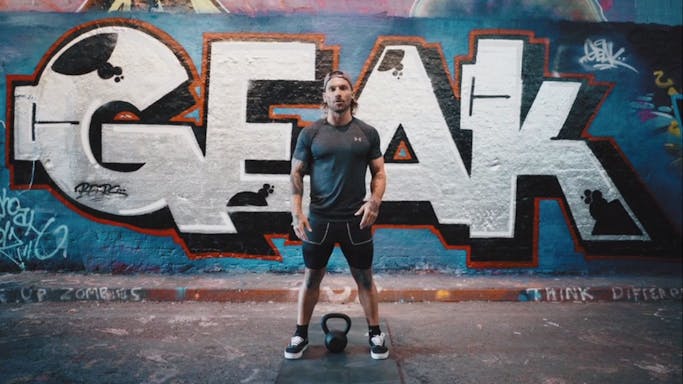Kettlebell Halo
by Sam Franklin
How to Master The Kettlebell Halo: The Orbital Upper Body Mobiliser
When it comes to kettlebell exercises that offer all in one control, conditioning, and mobility-boosting benefits, the kettlebell halo is hard to beat.
A fun, fluid, and incredibly versatile addition to any workout, the halo is certainly worth your attention. But, to reap any real rewards, getting your form just right is essential.
To help you on your quest for kettlebell halo glory, here’s everything you need to know to get started.
How to do a kettlebell halo: video tutorial
Before we dive into the benefits of kettlebell halo, watch our quick tutorial video by Luke Baden, Kettlebell Master Trainer.
Luke will take you step by step through the entire movement, ensuring your form is correct and you get the absolute maximum out of the exercise.
Step by Step Guide to the Kettlebell Halo
Step 1: The Kettlebell Halo
The Kettlebell Halo is a great shoulder strengthener and opener. It works well as part of your warm up, especially if you are going to be doing a lot of overhead work. To start, line up the malleolus, the ankle bones, with the horns of the bell.

Step 2: The Kettlebell Halo
Bend the knees and find the hip hinge. Grab the bell with an overhand grip. Push the floor away and drive up, flipping the kettlebell towards you.

Step 3: The Kettlebell Halo
Standing tall, the kettlebell is now upside down in front of the chest. When you're in this position, imagine that you are going to comb the side of your hair.

Step 4: The Kettlebell Halo
Drive the kettlebell to the side of the head, combing the hair. Keep your elbows high as you bring the kettlebell around the back of your head to the other side and back to the start position. Repeat in the opposite direction.

Step 5: The Kettlebell Halo
Keeping the elbows high, think about the kettlebell circumnavigating the head and running across the top of the shoulders or the top of your t-shirt. Remember to keep alternating sides.

The body-boosting benefits of the kettlebell halo
A kettlebell exercise that focuses on control and stability, the kettlebell halo is an excellent endurance builder. Here are the other body-boosting benefits of this popular kettlebell movement:
- Better mobility: Most upper body-based kettlebell exercises are fairly restricted when it comes to encouraging shoulder mobility, the halo hits the mark. The controlled, circular nature of the movement commands you to hold tension as you rotate the kettlebell, enhancing the mobility in your upper back and shoulders in the process. Improving your mobility will also make you more flexible—another plus point.
- Back and spine protection: As the kettlebell halo conditions the joints around the upper back and shoulders while strengthening muscles in the region, performing regular halos will help to protect your back and spine from injury.
- Core health: When performed well, the kettlebell halo engages almost every major muscle group in your torso area—which, in turn, will strengthen your core and boost your overall fitness levels.
What muscle groups does the kettlebell halo work?
We’ve established that the kettlebell halo works wonders for mobility while giving the core an excellent workout—but, what other muscle groups does it work? Let’s find out:
- The shoulders: Targeting the deltoids, rhomboids, trapezius muscles in one swift movement, the halo is excellent for conditioning as well as strengthening all of the shoulder's major muscle groups.
- The forearms: Essential for general arm tone and strength, working out the forearms is important. Performing regular halos will build your forearm muscles effectively.
- The erector spinae: A network of muscles and tendons that run along the length of your spine, focusing on your erector spinae region will improve your back strength, protect you from injury, and make your overall back as well torse area all the more resilient.
Kettlebell halo form tips
What to do
The kettlebell halo is an angelic kettlebell exercise but once false move and it could turn out to be demonic. To avoid injury or disappointment, here are some essential kettlebell halo form tips just for you:
- Starting position: Once you’ve picked up your kettlebell with due care, you should stand up straight with your feet shoulder-width apart, your toes pointing forward, and your shoulders (relaxed) positioned over your hips. Ensure that your knees are straight but flexed.
- Kettlebell position: Staying in position, clasp your kettlebell by the horns (the vertical sections of the handle) and turn it upsidedown so the ball is facing upwards. With slightly bent arms, hold the kettlebell at roughly chin height.
- The halo: Holding your posture, start to swing the kettlebell to your right, bringing it back behind your head in a smooth, controlled movement. Maintaining momentum, drop the height of the kettlebell slightly as it reaches your neck before completing the movement and bringing it back round to starting position.
- The change: Once you’ve completed a full circular movement, start moving the kettlebell around to the left, performing the movement in reverse. Remaining controlled and fluid at all times, repeat at your leisure.
What to avoid
Yes, the kettlebell halo is brilliant for your strength, mobility and fitness but if you get it wrong, you could hurt yourself. That said, here’s what to avoid:
- Don’t overswing the kettlebell at any time when performing halos. Doing so will cause you to lose control and will usually result in a painful back injury.
- Don’t stand too rigid when doing reps of halos. Make sure your shoulders, elbows, and knees are slightly flexed and relaxed throughout.
- Don’t overexert yourself by picking a weight heavier than you can handle. Choose your kettlebells wisely, starting small and increasing weight as your experience grows.
Related kettlebell halo exercises
If you want to supercharge your kettlebell halo efforts, here are some other kettlebell exercises you should try:
Kettlebell Halo video transcript
This is the video tutorial for Kettlebell Halo.
The kettlebell halo is a great shoulder strengthener, also a great shoulder opener.
It works as a great activation drill as part of your warmup, especially if you are going to be doing a lot of overhead work.
How we get the kettlebell into position is quite specific as well, in that we are going to take an overhand grip on the bell.
So, halo, looks like: approaching bell, malleolus in line with the horns.
Finding the hip hinge. Overhand grip.
Pushing floor away, driving up.
Kettlebell is now upside down in front of the chest.
When we’re in this position, I want you to imagine you’re combing the side of your hair.
So, driving the kettlebell to one side, combing the side of the hair, round the back of the head and then back to the start position.
From there, we’re going to do the same thing in the opposite direction.
Combing the side of the hair, elbows coming high, getting that kettlebell around the back of the head.
Try not to do something like this, okay.
Let’s think about getting the bell to circumnavigate the head and running across the top of the shoulders or the back of the t-shirt.
Kettlebell Halos, remembering to alternate sides.
This is going to be a great shoulder opener, also shoulder strengthener.
Also great as part of your warmup, especially if you’re doing upper body.
That was the kettlebell tutorial for the Halo.